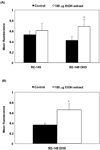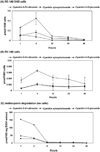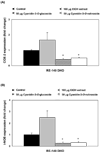Black raspberry components inhibit proliferation, induce apoptosis, and modulate gene expression in rat esophageal epithelial cells
- PMID: 20155622
- PMCID: PMC3015087
- DOI: 10.1080/01635580903285148
Black raspberry components inhibit proliferation, induce apoptosis, and modulate gene expression in rat esophageal epithelial cells
Abstract
We have shown that a diet containing freeze-dried black raspberries (BRB) inhibits the development of chemically induced cancer in the rat esophagus. To provide insights into possible mechanisms by which BRB inhibit esophageal carcinogenesis, we evaluated an ethanol (EtOH) extract of BRB, and two component anthocyanins (cyanidin-3-O-glucoside and cyanidin-3-O-rutinoside) in BRB, for their effects on growth, apoptosis, and gene expression in rat esophageal epithelial cell lines. The EtOH extract and both anthocyanins selectively caused significant growth inhibition and induction of apoptosis in a highly tumorigenic cell line (RE-149 DHD) but not in a weakly tumorigenic line (RE-149). The uptake of anthocyanins from the EtOH extract into RE-149 DHD cells far exceeded their uptake into RE-149 cells, which may have accounted for the selective effects of the extract on growth and apoptosis of RE-149 DHD cells. The growth inhibitory and proapoptotic effects were enhanced by the daily addition of the EtOH extract and the anthocyanins to the medium. Interestingly, the EtOH extract did not alter cyclooxygenase-2 (COX-2) and nitric oxide synthase (i-NOS) expression in RE-149 DHD cells, whereas both anthocyanins downregulated the expressions of these genes. This differential effect may have been related to the relative amounts of anthocyanins in the extract vs. when they were added individually to the medium. We conclude that the selective effects of the EtOH extract on growth and apoptosis of highly tumorigenic rat esophageal epithelial cells in vitro may be due to preferential uptake and retention of its component anthocyanins, and this may also be responsible for the greater inhibitory effects of freeze-dried whole berries on tumor cells in vivo.
Figures






Similar articles
-
Anthocyanins in black raspberries prevent esophageal tumors in rats.Cancer Prev Res (Phila). 2009 Jan;2(1):84-93. doi: 10.1158/1940-6207.CAPR-08-0155. Cancer Prev Res (Phila). 2009. PMID: 19139022 Free PMC article.
-
Protection against esophageal cancer in rodents with lyophilized berries: potential mechanisms.Nutr Cancer. 2006;54(1):33-46. doi: 10.1207/s15327914nc5401_5. Nutr Cancer. 2006. PMID: 16800771 Free PMC article.
-
Identification of cyanidin glycosides as constituents of freeze-dried black raspberries which inhibit anti-benzo[a]pyrene-7,8-diol-9,10-epoxide induced NFkappaB and AP-1 activity.Carcinogenesis. 2006 Aug;27(8):1617-26. doi: 10.1093/carcin/bgi366. Epub 2006 Mar 7. Carcinogenesis. 2006. PMID: 16522666 Free PMC article.
-
Cancer prevention with freeze-dried berries and berry components.Semin Cancer Biol. 2007 Oct;17(5):403-10. doi: 10.1016/j.semcancer.2007.05.001. Epub 2007 May 10. Semin Cancer Biol. 2007. PMID: 17574861 Free PMC article. Review.
-
Do anthocyanins and anthocyanidins, cancer chemopreventive pigments in the diet, merit development as potential drugs?Cancer Chemother Pharmacol. 2009 Jun;64(1):201-11. doi: 10.1007/s00280-009-0976-y. Epub 2009 Mar 18. Cancer Chemother Pharmacol. 2009. PMID: 19294386 Review.
Cited by
-
Strawberry phytochemicals inhibit azoxymethane/dextran sodium sulfate-induced colorectal carcinogenesis in Crj: CD-1 mice.Nutrients. 2015 Mar 10;7(3):1696-715. doi: 10.3390/nu7031696. Nutrients. 2015. PMID: 25763529 Free PMC article.
-
Anti-apoptotic effect of banhasasim-tang on chronic acid reflux esophagitis.World J Gastroenterol. 2017 Jul 7;23(25):4644-4653. doi: 10.3748/wjg.v23.i25.4644. World J Gastroenterol. 2017. PMID: 28740353 Free PMC article.
-
Evaluation of The Protective Effect of Hydro-Alcoholic Extract of Raspberry Fruit on Aquaporin1 Expression in Rats Kidney Treated by Methotrexate.Cell J. 2017 Jul-Sep;19(2):306-313. doi: 10.22074/cellj.2016.3957. Epub 2017 Feb 22. Cell J. 2017. PMID: 28670523 Free PMC article.
-
Berries vs. Disease: Revenge of the Phytochemicals.Pharmaceuticals (Basel). 2024 Jan 9;17(1):84. doi: 10.3390/ph17010084. Pharmaceuticals (Basel). 2024. PMID: 38256917 Free PMC article. Review.
-
A nutrigenetic approach for investigating the chemopreventive effects of black raspberries during the development of preneoplastic esophagi in rats.J Berry Res. 2018;8(4):263-274. doi: 10.3233/JBR-180346. Epub 2018 Dec 20. J Berry Res. 2018. PMID: 30613310 Free PMC article.
References
-
- Parkin DM, Pisani P, Ferlay J. Estimates of the worldwide incidence of 25 major cancers in 1990. Int J Cancer. 1999;80:827–841. - PubMed
-
- Jemal A, Siegel R, Ward E, Hao Y, Xu J, et al. Cancer statistics, 2008. CA Cancer J Clin. 2008;58:71–96. - PubMed
-
- Daly JM, Fry WA, Little AG, Winchester DP, McKee RF, et al. Esophageal cancer: results of an American College of Surgeons patient care evaluation study. J Am Coll Surg. 2000;190:562–573. - PubMed
-
- Flood WA, Furastiere AA. Esophageal cancer. Curr Opin Oncol. 1995;7:381–386. - PubMed
-
- Kelsen D. Preoperative chemoradiotherapy for esophageal cancer. J Clin Oncol. 2001;19:283–285. - PubMed
Publication types
MeSH terms
Substances
Grants and funding
LinkOut - more resources
Full Text Sources
Medical
Research Materials
